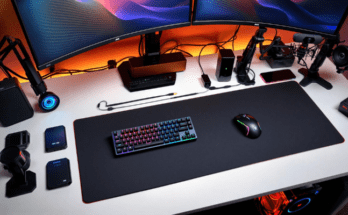Introduction
The decision to buy a computer for whatever purpose, whether for business use, fun or learning requires a lot of thought and homework. Even the user with a high level of IT literacy might get confused because of the variability of products offered on the market today. This comprehensive computer buying guide will give you important information for choosing the best computer depending on your wants and needs.
1. Identify Your Needs and Usage
It is however important to break down the specifications based on their relevance to the need or use of the computer in question. Let it be said, always decide whether you require a desktop, a laptop or a tablet may be. Other things to consider are portability, the performance and the cost.
Workstation: For usage such as office work, gaming, video editing or some other hard workers desktop computer would not disappoint you. They are generally faster, simpler to upgrade and have greater screen size than laptops.
Laptops: Laptops are portable and thus ideal for business people, students, or anyone else that requires a portable device. However, they have lesser up gradation facilities and in most cases they offer low performance as compared to desktops.
Tablets: It is easy to understand that the utility of tablets in media consumption, note taking and other casual usage is due to their portability. Attachments of keyboards are also commonly implemented within most models for add-on usability.
2. Evaluate Your Budget
As will be seen in this review there are high quality devices in the market today making the available budget a critical consideration during the purchase of a computer. Never forget other expenses, such as final output peripherals, software or just the costs of maintaining.
Low Budget: For normal users who only require internet connectivity for browsing and limited office work and documents editing, there are several low end affordable models from $200.
Mid-range Budget: For average clients, like students and home users, a device that can cost between $500 and $1000 will be sufficient to meet their needs without excessive extras.
High-end Budget: A gaming computer will cost between $1000 and $3000 for a professional, or video editors, musician and designers. The higher end of the devices can be tweaking or upgraded to the highest component possible.
3. Consider Processor and RAM
The basic processing ability of a computer is defined by the CPU known also as the processor. Today, the motherboard and CPU market offers the Intel Core and AMD Ryzen chipset for different customers’ segments.
Intel Core: Provides a wide set of processors characterized by various performance and power consumption parameters. The i3 is designed for those who do not use the computer much although doing the basic operation the i5 is suitable for a medium user and the i7 is recommended for gamers and or professionals. The i9 series is limited to workstation grade computing platform.
AMD Ryzen: Common for great multitasking, Ryzen processors provide a high performance and have a lower price as compared to Intel processors. The Ryzen 3 and 5 are general use CPUs while Ryzen 7 and 9 are recommended for gamers and professionals.
One main element of the multitasking is RAM, which one improves one’s performance. Basic usage requires minimum of 8 GB RAM, medium usage requires minimum of 16 GB RAM and above 32 GB RAM for high usage, i.e professional gamer etc.
4. Choose a Suitable Graphic Card
Having a Graphics Processing Unit (GPU) is crucial for gaming, video and graphic operations among others. In the market, there are two major brands: Nvidia GeForce, and AMD Radeon, and each of them offers a huge selection of choices based on price and complexity.
If you only need to run low end graphics and casual and entry level video gaming, you can get away with using an integrated graphics card that comes with the processor — in other words, the graphics is all built into the chip — and you don’t have to buy any of that separately. But for serious games and the professional ones, having a dedicated graphics card for a computer should be encouraged.
5. Storage Consideration
Storage measures how much data your computer can store. An SSD is faster and more shock resistant than an ordinary HDD. For the basic users I believe 256 GB SSD should suffice. For mid-users, or professional, a 512 local SSD or 1 local SSD can be used, and for others who work, store many files, an HDD can also be used to supply extra storage.
6. Which Operating System to Use
Operating system (OS) is one of the core components of your computer that makes a decision on the compatibility of other softwares as well as the operations interface. Finally we have a choice between Windows 10 and macOS.
Windows 10: However, by keeping up with the traditional aesthetics, its ease of use, facility to support most of the software’s and devices, Windows 10 has been most preferable among all.
macOS: Tailored for Apple devices, macOS is chosen by people who appreciate design, ease of use and an ability to harmoniously coexist with other devices produced by Apple.
7. Internet Surfing and Social Customer Feedback
To take a better decision spend quality time in doing online research and scrape customer review from tech blogs, forum sites, and e-commerce sites. This will assist in getting an understanding of how the device is performing, what can go wrong with it and also the company’s customer care department.
8. Warranty and return policy
Either being the one who is selling or the one buying it – always it is advisable to know the warranty and return policy of the device as well as the store from where you are buying it. A small warranty, when you have minimal assurance of the product’s manufacturing defect or technical problems. In addition, free return guarantee means that the buyer can return a device if it was not satisfactory to him.
Conclusion
Equipped with the ultimate computer buying guide, you should be ready to make the right decision. Do not forget to pin down the things you will need, weigh your budget, and think about some must-have features such as processor, RAM, integrated and dedicated graphics, storage, and operating system. To ensure you have chosen the right computer companion do your research online, read the warranties and customer reviews. Happy shopping!



